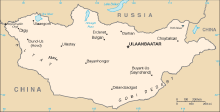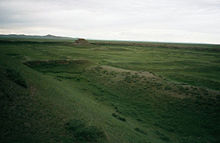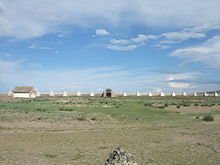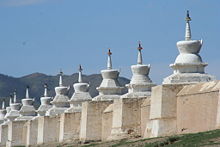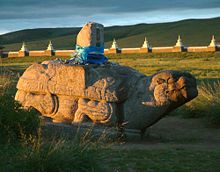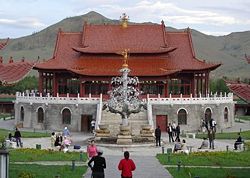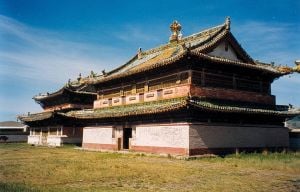Orkhon Valley Cultural Landscape
| Orkhon Valley Cultural Landscape* | |
|---|---|
| UNESCO World Heritage Site | |
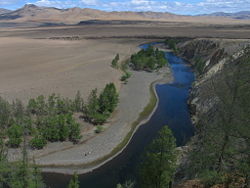
| |
| State Party | |
| Type | Cultural |
| Criteria | ii, iii, iv |
| Reference | 1081 |
| Region** | Asia-Pacific |
| Inscription history | |
| Inscription | 2004Â (28th Session) |
| * Name as inscribed on World Heritage List. ** Region as classified by UNESCO. | |
Orkhon Valley Cultural Landscape is seen along the banks of the Orkhon River in Central Mongolia, 360Â kilometers (220Â mi) west from the capital Ulaanbaatar. The Orkhon Valley was the site of imperial Mongol power from the sixth century C.E. with the Uyghur Empire and climaxing, most importantly, with Genghis Khan. He ruled the largest empire in history during the thirteenth and fourteenth centuries. His influence extended westward to Europe, throughout China, and onto the Indian subcontinent. Despite the extent of the empire, and the power wielded at it's height, little remains in the twenty first century that speaks to its enormous impact upon the lands of the world in its day.
A number of important sites remain, however. Ordu-Baliq (Khar Balgas), the eighth century capital of the Uyghur Empire, served as the first capital of the empire. Archaeological discoveries reveal palaces, temples, merchant shops, and monasteries throughout the 50 square kilometers (19 sq mi) area. Karakorum served as the capital of Genghis Khan for thirty years during the thirteenth century. It is situated in one of the most ancient farming areas in Mongolia. Kublai Khan relocated his capital to Shangdu after taking the throne of the Mongol Empire in 1260 C.E., marking the steady decline of Karakorum from that time. Xanadu, Kublai Khan's summer capital during the Yuan Dynasty in China, and the Erdene Zuu Monastery represent two other noteworthy sites within the Orkhon Valley. The Erdene Zuu Monastery represents an adaptation of Buddhism to Mongolian culture, earning the name Mongolian Buddhism. UNESCO designated Orkhon Valley Cultural Landscape a World Heritage site in 2004, noting its nomadic pastoral traditions spanning more than two millennia and its role as the capital region of one of the largest and most powerful empires in history.
Importance
For many centuries, the Orkhon Valley served as the seat of the imperial power of the steppes. A stele with runic inscriptions, erected in the valley by Bilge Khan, an eighth century ruler of the GöktĂŒrk Empire, provides the first evidence of that historic role. His ĂrdĂŒ, or nomadic capital, unfolded twenty five miles to the north of the stele in the shadow of the sacred forest-mountain ĂtĂŒken. During the Qidan domination of the valley, they reinscribed the stele in three languages to record the deeds of a Qidan potentate.
Tengriism holds the mountains sacred as an axis mundi yet the ĂtĂŒken especially held them sacred because the ancestor spirits of the khagans and beys resided in them. Tengriism teaches that a force called qut emanates from the mountain, granting the khagan the divine right to rule the Turkic tribes.[1] Whoever controlled the valley was considered heavenly appointed leader of the Turks and could rally the tribes. Thus control of the Orkhon Valley held the utmost strategic importance for every Turkic state. Historically every Turkic capital (ĂrdĂŒ) was located here.
Sites
The main monuments of the Orkhon Valley follow:
Ordu-Baliq (Khar Balgas)
Ruins of Ordu-Baliq , an eighth century capital of the Uyghur Empire, cover fifty square kilometers revealing evidence of the palace, shops, temples, and monasteries. Ordu-Baliq (variously spelled Ordu Balykh, Ordu Balik, Ordu-Baliq, Ordu Balig, Ordu Baligh, meaning "city of the court"), also known as Mubalik, served as the capital of the first Uyghur Empire. Built on the site of the former GöktĂŒrk imperial capital, it sits seventeen kilometers north-to-northeast of the later Mongol capital, Karakorum. Known as Kharabalghasun (Karabalgasun, Kara Balgasun, Khar Balgas), "black city," the ruins form part of the World Heritage Site Orkhon Valley Cultural Landscape.
Location
Ordu-Baliq is situated in a grassy plain called the Talal-khain-dala teppe, on the western bank of the Orkhon River in the Khotont sum of the Arkhangai Province, Mongolia, sixteen kilometers northeast of the Khotont village, or thirty kilometers north-to-northwest of Kharkhorin. The Orkhon emerges from the gorges of the Khangai Mountains and flows northward to meet the Tuul River (on whose upper reaches the current capital of Mongolia, Ulan Bator, is located). A favorable micro-climate makes the location ideal for pasturage, and it lies along the most important east-west route across Mongolia. As a result, the Orkhon Valley was a center of habitation and important political and economic activity long before the birth of Genghis Khan, who made it world famous.
History
In 744 C.E., after the defeat of the last GöktĂŒrk Kaghan by the Uigur-Qarluk-Basmyl alliance, the Uyghurs under Bayanchur Khan established their imperial capital Ordu Baliq on the site of the old ördĂŒ ("nomadic capital"). Designed by Sogdian architects, Ordu Baliq may have been the earliest walled city in Mongolia. Ordu-Baliq flourished until 840 C.E. when demolished by the invading Yenisey Kyrgyzes.
The capital occupied twenty five square kilometers. The ruins of the town, which include the ten meter high town wall, a twelve meter high tower and another fourteen meter high sentry tower, reveal Ordu Baliq as an affluent and large town. The urban area divides into three main parts. The central and largest part consisted of numerous buildings surrounded by a continuous wall. Ruin of many temples and dwelling houses lay to the south beyond the center. The Khan's residential palace, also ringed by high walls on all sides, stood in the northeastern part of the town. The Russian archaeologist Nikolay Yadrintsev discovered a green granite monument with a statue of a dragon perched at the top and bearing a runic inscription glorifying the khagans at that spot.
Ordu Baliq was a fully-fortified commandry and commercial entrepot typical of the central points along the length of the Silk Road. The well-preserved remains now consist of concentric fortified walls and lookout towers, stables, military and commercial stores, and administrative buildings. Remains of a water drainage system have been discovered. Archaeologists established that certain areas of the town were allotted for trade and handcrafts, while in the center of the town stood palaces and temples, including a monastery. The palace had fortified walls around it and two main gates, north and south, as well as moats filled with water and watchtowers.
An Arab ambassador from the Samanid Empire, Tamim ibn Bahr, visited Ordu Baliq in 821 C.E. and left the only written account of the city. He traveled through uninhabited steppes until arriving in the vicinity of the Uighur capital describing Ordu-Baliq as a great town, "rich in agriculture and surrounded by rustaqs (villages) full of cultivation lying close together. The town had twelve iron gates of huge size. The town was populous and thickly crowded and had markets and various trades."[2] The most colorful detail of his description is the 100-foot (30Â m)-high golden yurt on top of the citadel where the khagan held court.
Discovery
In 1871, the Russian traveler Paderin became the first European to visit the ruins of the Uighur capital, of which only the wall and a tower existed, while the streets and ruins outside the wall could be seen at a distance. He learned that the Mongols call it either Kara Balghasun ("black city") or khara-kherem ("black wall"). Paderin's assessment that it had been the old Mongol capital Karakorum has been proven incorrect.
The Mongolian Karakorum, has been identified by several authorities with a site on which the sixteenth century Buddhist Erdene Zuu monastery had been built, some seventeen kilometers to the southeast. North and north-east of the monastery lay ruins of ancient buildings. Nikolay Yadrintsev identified the site as a ruined Uyghur capital in 1889. Two expeditions of the Helsingfors Ugro-Finnish society in 1890, and one by the Russian Academy of Sciences under Friedrich Wilhelm Radloff 1891, followed.
Karakorum
Ruins of Genghis Khan's capital Karakorum may have included the famed Xanadu palace. Karakorum (Khalkha Mongolian: Khara-khorin, Classical Mongolian: Qara Qorum) served as the capital of the Mongol Empire in the thirteenth century for only about thirty years. Its ruins lie in the northwestern corner of the Ăvörkhangai Province of Mongolia, near Kharkhorin, and adjacent to the Erdene Zuu monastery.
History
Foundation. The Orkhon valley had already been a center of the Xiongnu, GöktĂŒrk and Uighur empires. To the GöktĂŒrks, the nearby Khangai Mountains had been the location of the ĂtĂŒkĂ€n, and the Uighur capital Karabalgasun had been located close to Karakorum. That area constitutes one of the oldest farming areas in Mongolia.[3]
In 1218 to 1219, Genghis Khan rallied his troops for the campaign against the Khwarezm Empire in Karakorum;[4] the building of the city began 1220. Karakorum had been little more than a yurt town until 1235, after the defeat of the Jin empire. In that year Genghis' successor Ăgedei erected walls around the place and build a palace.[5]
Prosperity. Under Ăgedei and his successors, Karakorum became a major center for world politics. Möngke Khan had the palace enlarged, and the great stupa temple completed.[5]
William of Rubruck. William of Rubruck, a Flemish Franciscan missionary and papal envoy to the Mongols reached Karakorum in 1254 C.E.. He has left one of the most detailed, though not always flattering, accounts of the city. He compared it rather unfavorably to the village of Saint-Denis near Paris, and stated that the monastery in said village is ten times as important as the Khan's palace. On the other hand, he described the town as cosmopolitan and religiously tolerant. The silver tree he described as part of Möngke Khan's palace has become the symbol of Karakorum.[5] He described the walled city as having four gates in the four main directions, a "Saracenes" and "Cathai" (Northern Chinese) quarter, twelve pagan temples, two mosques, as well as a Nestorian church.[5]
Later Times. When Kublai Khan took the throne of the Mongol Empire in 1260 C.E., he relocated his capital to Shangdu, and later to Dadu (Beijing). Karakorum decline into the administrative center of a provincial backwater of the Yuan Dynasty by 1271 C.E. Even worse, the ensuing wars between Kublai Khan and his brother Ariq Boke and nephew Kaidu reduced the city. In 1260, Kublai disrupted the town's grain supply, in 1277 Kaidu took Karakorum, only to be ousted by Yuan troops and Bayan of the Baarin the following year.[6] By 1299, prince Ulus Buqa looted the markets and the grain storehouses. The first half of the fourteenth century, prosperity returned to Karakorum. In 1299, the town expanded eastwards, in 1311 and again from 1342 to 1346, the stupa temple (after 1346 known as Xingyuange (Traditional Chinese: èć éŁ, "Pavillion of the Rise of the Yuan") revived.[5]
Decline. After the collapse of the Yuan dynasty in 1368, Karakorum became the residence of BiligtĂŒ Khan in 1370. In 1388, Ming troops under General Xu Da destroyed the city. In 1415, Khuriltai has been credited with rebuilding decided to rebuild Karakorum, but no archeological evidence for such a venture has been found yet. In any case, Karakorum had inhabitants at the beginning of the sixteenth century, when Batu-Möngke Dayan Khan reestablished it as a capital city. In the following years, the town changed hands between Oirads and Chinggisids several times, after which the city became desolate.[5]
Excavations. In 1585, Abadai Khan of the Khalkha built the Tibetan Buddhist Erdene Zuu monastery near the site. Builders used debris from the city build the monastery.
The actual location of Karakorum became uncertain. The first indication that Karakorum might have been located at Erdene Zuu appeared in the eighteenth century. In 1889, Nikolai Yadrintsev convincingly identified the site as the former Mongol; he discovered the Orkhon script during the same expedition.
Excavations unearthed paved roads, some brick and many adobe buildings, floor heating systems, bed-stoves, evidence for processing of copper, gold, silver, iron (including iron wheel naves), glass, jewels, bones, and birchbark, as well as ceramics and coins from China and Central Asia. Four kilns have also been unearthed.[7][8]
Xanadu
| Xanadu Chinese: äžéœ; pinyin: ShĂ ngdĆ« Zanadu, Shangdu, or Shang-tu |
|
| Coordinates: {{#invoke:Coordinates|coord}}{{#coordinates:42|21|35|N|116|10|47|E|type:city | |
|---|---|
| name= }} | |
| Coordinates: | |
Xanadu, also Zanadu, Shangdu, or Shang-tu (Chinese: äžéœ; pinyin: ShĂ ngdĆ«) had been Kublai Khan's summer capital during the Yuan Dynasty in China, a division of the Mongol Empire (which covered much of Asia and also encroached upon eastern Europe). The city, located in Inner Mongolia, 275 kilometers (171 mi) north of Beijing, sat 28 kilometers (17 mi) northwest of Duolun. The capital formed a square shape, with each side approximately 2200 meters, consisting of outer and inner section. In inner section lay in the southeast part of the capital, having a square layout with sides about 1400 meters in length. The palace, where Kublai Khan stayed in summer, stood in the inner section of the city. The palace had walls in a square, each measuring 550 meters or about forty percent the size of the Forbidden City in Beijing. The earthen walls still stand as well as a ground-level, circular brick platform in the center of the inner enclosure. Venetian explorer Marco Polo visited Xanadu in 1275; it became fabled as a metaphor for opulence, most famously in the English Romantic Samuel Taylor Coleridge's poem Kubla Khan.
Erdene Zuu Monastery
The Erdene Zuu monastery (Mongolian: ĐŃĐŽŃĐœŃ ĐŃŃ) may have been the first Buddhist monastery in Mongolia. Located in Ăvörkhangai Province, near the town of Kharkhorin and adjacent to the ancient city of Karakorum, it is part of the Orkhon Valley Cultural Landscape World Heritage Site .
Abtai Sain Khan built the Erdene Zuu monastery in 1585 upon the (second) introduction of Tibetan Buddhism into Mongolia. Stones from the ruins of Karakorum were used in construction.[9] The monastery boasts 102 stupas. The number 108, being a sacred number in Buddhism,[10] and the number of beads in a Buddhist rosary, was probably envisioned, but never achieved.[11] The monastery temples' walls had been painted, and the Chinese-style roof covered with green tiles. The monastery suffered extensive damage during warfare in the 1680s. It underwent restoration in eighteenth and nineteenth centuries, the sixty two temples brought back to their origional condition by 1872.
In 1939, the Communist leader Khorloogiin Choibalsan destroyed the monastery as part of a campaign to destroy monasteries throughout Mongolia, killing more than ten thousand monks during the persecution.[12] Three small temples and the external wall with the stupas survived, the temples becoming museums in 1947. That part of the monastery may have been spared on Joseph Stalin's command. United States vice president Henry A. Wallace's delegation to Mongolia in 1944 may have given rise to the order.[13]
Erdene Zuu existed solely as a museum. Communists permitted only Gandantegchinlen Khiid Monastery in the capital, Ulaanbaatar, to operate. After the fall of Communism in Mongolia in 1990, the government returned Erdene Zuu monastery to the lamas. Erdene Zuu remains an active as Buddhist monastery as well as a museum.
Gallery
A Buddha at the monastery
Additional significant sites
- Early eighth century Turkic memorials to Bilge Khan and Kul Tigin with their Orkhon inscriptions stand as impressive monuments from the nomadic GöktĂŒrk Empire. They had been excavated and deciphered by Russian archaeologists between 1889 to 1893.
- Remains of the thirteenth and fourteenth century Mongol palace at Doit Hill, thought to be Ăgedei Khan's residence.
- Tuvkhun Hermitage, a spectacular monastery, stood on a hill at 2,600 meters above sea-level. Communists virtually destroyed the hermitage.
See also
Notes
- â Herbert Franke, The Cambridge History of China (Cambridge University Press, 1994), 347.
- â Minorsky, 2006.
- â Micheal Walther, Ein idealer Ort fĂŒr ein festes Lager, Zur Geographie des Orchontals und der Umgebung von Charchorin (Karakorum), in: Dschingis Khan und seine Erben, 128.
- â Micheal Weiers, Geschichte der Mongolen (Stuttgart 2004), 76.
- â 5.0 5.1 5.2 5.3 5.4 5.5 Hans-Georg HĂŒttel, Karakorum-Eine historische Skizze, in Dschingis Khan und seine Erben, 133-137.
- â Rolf Trauzettel, Die YĂŒan-Dynastie, in: Michael Weiers (editor), Die Mongolen, BeitrĂ€ge zu ihrer Geschichte und Kultur (Darmstadt 1986), 230.
- â Christina Franken, Die Brennöfen im Palastbezirk von Karakorum, in Dschingis Khan und seine Erben, 147-149.
- â Ulambayar Erdenebat, Ernst Pohl, Aus der Mitte der HauptstadtâDie Ausgrabungen der UniversitĂ€t Bonn im Zentrum von Karakorum, in: Dschingis Khan und seine Erben, 168-175.
- â Culture Mongolia, Karakorum. Retrieved October 10, 2008.
- â Lynn Snipe, Buddhism in the Numbers. Retrieved October 10, 2008.
- â Niels Gutschow, Andreas Brandt, Die Baugeschichte der Klosteranlage von Erdeni Joo (Erdenezuu), in Claudius MĂŒller (ed.), Dschingis Khan und seine Erben (Bonn 2005), 353.
- â Mongolia Today, Terror Years. Retrieved October 10, 2008.
- â KarĂ©nina Kollmar-Paulenz, Buddhism in Mongolia After 1990. Retrieved October 10, 2008.
ReferencesISBN links support NWE through referral fees
- This article incorporates public domain text posted on-line by The United States Library of Congress: A Country Study: Mongolia.
- Drompp, Michael Robert. Tang China and the Collapse of the Uighur Empire: A Documentary History. Brill, 2005. ISBN 9004141294.
- Franke, Herbert. 1994. The Cambridge History of China. Cambridge University Press. ISBN 0521214475.
- Kunst- und Ausstellungshalle der Bundesrepublik Deutschland, and Staatliches Museum fĂŒr Völkerkunde MĂŒnchen. 2005. Dschingis Khan und seine Erben: das Weltreich der Mongolen. MĂŒnchen: Hirmer. ISBN 9783777425450.
- Minorsky, V. Tamīm ibn Baងr's Journey to the Uyghurs. Bulletin of the School of Oriental and African Studies 12 (2): 31. ISSN 0041-977X.
- Roth, Helmut R., Ulambaja Erdenbat, Ernst Pohl, and Eva Nagel. 2002. Qara Qorum-City (Mongolia). Bonn contributions to Asian archaeology, v. 1. Bonn: Institute of Pre- and Early Historical Archaeology. ISBN 9783936490015.
- Weiers, Michael. 1986. Die Mongolen: BeitrÀge zu ihrer Geschichte und Kultur. Darmstadt: Wissenschaftliche Buchgesellschaft. ISBN 9783534035793.
- Weiers, Michael. 2004. Geschichte der Mongolen. Urban-TaschenbĂŒcher, 603. Stuttgart: Kohlhammer. ISBN 9783170172067.
External links
All links retrieved November 17, 2022.
- Karakorum
- Map of cities along the Silk Road.
- William of Rubruck's Account of the Mongols.
- Picture story by German photographer Marc Steinmetz for GEO magazine.
- Shangdu Google Satellite Map.
- Shangdu city uncovered.
- Erdene Zuu: Pictures.
| |||||||
Credits
New World Encyclopedia writers and editors rewrote and completed the Wikipedia article in accordance with New World Encyclopedia standards. This article abides by terms of the Creative Commons CC-by-sa 3.0 License (CC-by-sa), which may be used and disseminated with proper attribution. Credit is due under the terms of this license that can reference both the New World Encyclopedia contributors and the selfless volunteer contributors of the Wikimedia Foundation. To cite this article click here for a list of acceptable citing formats.The history of earlier contributions by wikipedians is accessible to researchers here:
The history of this article since it was imported to New World Encyclopedia:
Note: Some restrictions may apply to use of individual images which are separately licensed.
